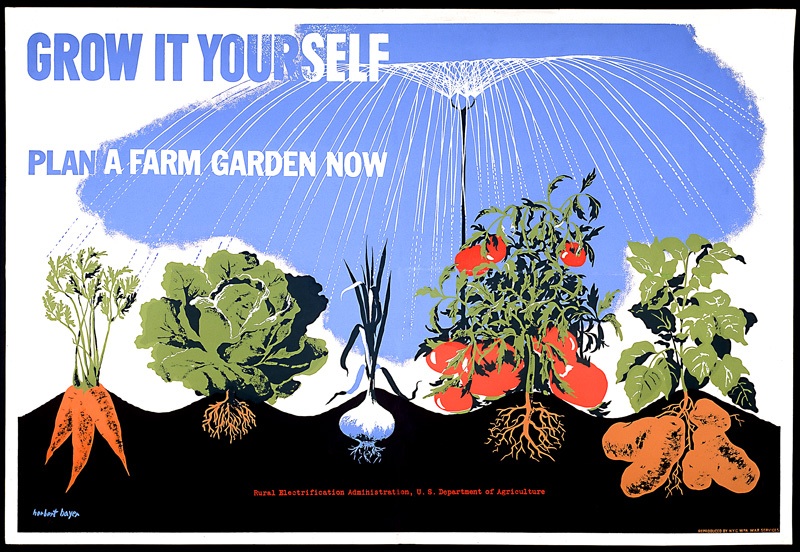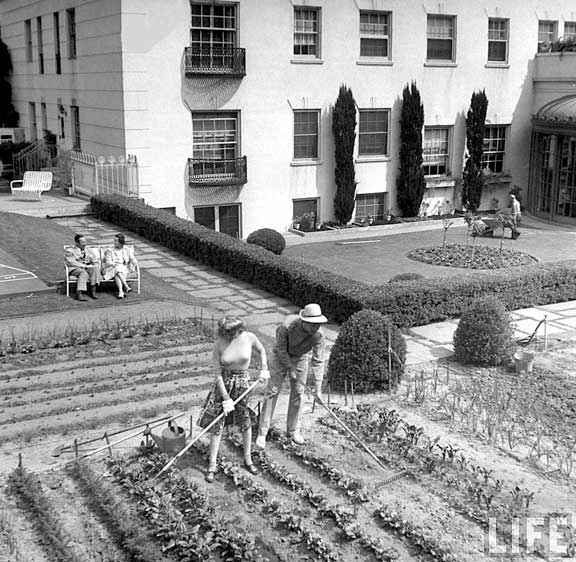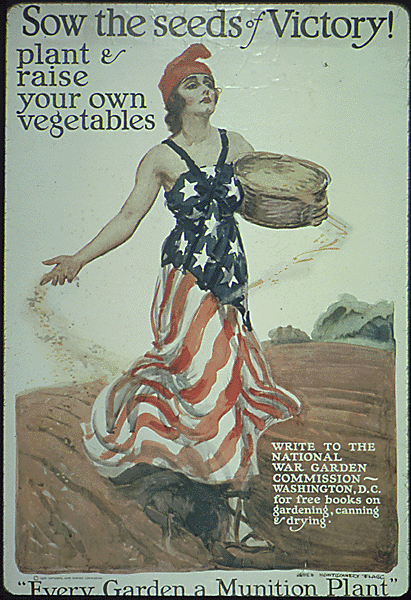The Blogging Farmer
Alex Tiller’s Blog on Agriculture and Farming***
‘Victory Gardens’: Everything Old is New Again
There's an old saying: "An army marches on its stomach."
It's something that Europeans didn't quite figure out back during the "War to End all Wars" when an entire generation of young European men was decimated for questionable causes that historians still aren't clear about. Since these men were busy getting butchered in the trenches instead of working on farms, it should not have been a surprise that food shortages were an epidemic during the First World War.
The American farmer was a beneficiary of this situation; our country didn't get involved until 1917, and as you might guess, there was a big market in Europe for American grain and produce such as root vegetables. In March of that year, when U.S. involvement started looking inevitable, millionaire Charles L. Pack started a campaign, urging everybody to plant "War Gardens." A generation later during the Second World War, "Victory Gardens" again became an important institution. It was not only a way to free up agricultural resources that could be used to feed the Armed Services, it also helped families cope with rationing and the high cost of fresh produce—and gave them a certain sense of pride, realizing they were doing their part in the war effort.
Well folks—looks like the Victory Garden is once again making a comeback, though perhaps for different reasons.
It's interesting to note how this history is repeating itself in more ways than one. Back during World War II, then-First Lady Eleanor Roosevelt caught some flack from the Secretary of Agriculture for planting a Victory Garden on the White House grounds, fearing that it would hurt commercial agriculture. Nonetheless, within a few months, the USDA was publishing and distributing instructional literature on the topic, and by 1945, there was as much fruits and vegetables being grown in people's backyards and community gardens as there was on the nation's farmlands (around ten million tons).
Recently, Michelle Obama raised a few eyebrows when she brought back her predecessor's Victory Garden as the White House Kitchen Garden. Despite its detractors, that garden just passed the one-year mark, and is doing well—as it inspires private citizens all over the country to follow suit.
Today, it's less about the war effort and more about people taking control over their food supply. It's true that nobody cares about your diet as much as you do, and with salmonella and e-coli scares as well as concern over pesticides, GMOs and chemical fertilizers, folks are finding that the only way to be sure about what's going into their food is to grow their own.
There's a more practical angle to all of this. At current trends, within the next forty years we're going to have nine billion mouths to feed on this rock. Roger Doiron, founder of Kitchen Gardeners International, summed it up this way:
"...we will need to produce more food over the course of the next 40 years than civilization has produced over the course of the past 10,000 years combined...small food gardens are going to play a big role in making this happen.”Get to work, folks.
Posted on June 2, 2010 at Alex Tiller’s blog, http://blog.alextiller.com/
***
Victory Garden at Town House USA, 1943 (Photo: Walter Sanders)‘Victory Gardens’: Need More Reasons?
If you're really worried about issues like chemical adulteration of your food, GMO crops, working conditions for farm laborers, fossil fuels and global climate change and animal welfare and even bio-terrorism—eat what's grown locally and focus on what's in season.
This is a growing trend that even big chain supermarkets like Safeway and Fred Meyer are starting to notice. Both of these companies are increasingly turning to local suppliers for their produce and even many meat products. So are restaurants, including regional chains like In-And-Out Burger in Southern California, Burgerville in the Pacific Northwest and Colorado's Chipotle Mexican Grill.
I've talked about this a few times here, but it bears repeating, particularly in light of the recent example of criminal negligence in the Gulf of Mexico. Food raised locally—within a 200 mile radius—does not have to rely as much on petroleum to get from Point A to Point B. But here's some reasons that hit closer to home.
First of all, that food's going to be fresher and will be more nutritious. The problem with shipping produce a thousand miles or more is that in order to survive the trip, it needs to be picked before it's ripe. If you've ever been subjected to the tastelessness of green, unripe fruit, you know what I'm talking about.
Of course, the issue that's got everyone's shorts in a knot is terrorism. Now, I'm not too worried about people with bombs strapped to their bodies, but I have to say that the idea of someone sneaking into a commercial food processing plant and dropping a heapin' helping of e-coli or anthrax into the works—that bothers me (and it would be relatively easy to get away with). However, it's a lot less likely that some nut-case is going to be able to pull it off when the food is consumed close to its source.
Another issue that is on everyone's mind is the paving over of America as more and more farmland winds up being turned into strip malls and housing developments. When you support your local farmer, you're giving him/her a reason to stay in business—and when the developer comes around with a sales pitch and a wad of cash, s/he's more likely to tell this character to take a hike.
You can't do much better than growing your own in your backyard. Since every region of the country is different, however, you'll need to have some ideas as to what you can raise. Fortunately, there's a fair number of websites out there that are focused toward local agriculture and gardening. For example, Front Range Living is one such online resource geared toward people living in the Denver area. For folks living in and around Portland, Oregon, check out Minerva's Garden; this site is updated regularly and even has a couple of nifty videos. Vegetable gardeners in the Southeast should check out Veggie Gardening Tips. Just go to your favorite search engine (it doesn't have to be Google or Yahoo—there are a few more out there), enter "vegetable gardening tips" and your location. You'll be surprised at how many helpful folks there are out there when it comes to growing your own.
Posted on June 7, 2010 at http://blog.alextiller.com/
An Urban Victory Garden: John from www.growinggreens.com explains what worked and what didn’t work in his suburban Victory Garden***
Hello, and thanks for checking out my blog. My name is Alex Tiller and I grew up in rural Ohio (Clark County) where my family still owns farmland (corn and beans). I am a member of the American Society of Farm Managers and Rural Appraisers and am also an agribusiness author/blogger. I write about commercial farming, family farms, organic food production, sustainable agriculture, the local food movement, alternative renewable energy, hydroponics, agribusiness, farm entrepreneurship, and farm economics and farm policy. I visit lots of farms in different areas of the country (sometimes the world) that grow all kinds of different crops and share what I learn with you through this blog.
You can contact me via email by clicking here: Email Alex (http://blog.alextiller.com/contact)
Founder/Publisher/Editor: David McGee
Contributing Editors: Billy Altman, Laura Fissinger, Christopher Hill, Derk Richardson
Logo Design: John Mendelsohn (www.johnmendelsohn.com)
Website Design: Kieran McGee (www.kieranmcgee.com)
Staff Photographers: Audrey Harrod (Louisville, KY; www.flickr.com/audreyharrod), Alicia Zappier (New York)
E-mail: thebluegrassspecial@gmail.com
Mailing Address: David McGee, 201 W. 85 St.—5B, New York, NY 10024






